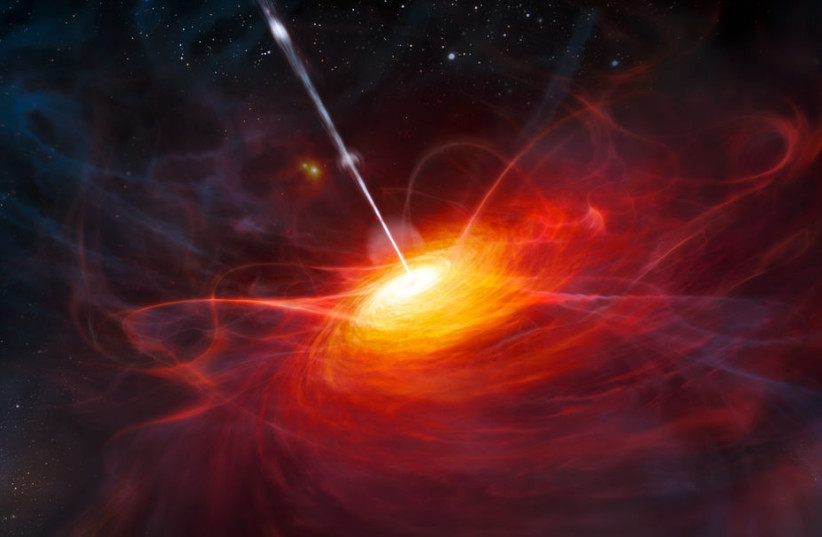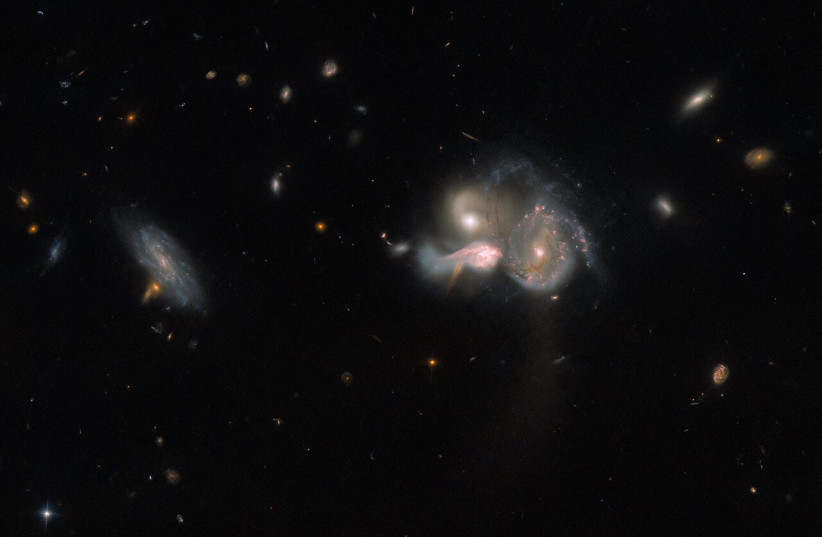A recently observed galaxy from the early days of the universe is incredibly large but also all alone. A new study believes this may be because it essentially consumed its galaxy neighbors.
The findings of this study were published in the peer-reviewed academic periodical The Astrophysical Journal.
The research was conducted using the Chandra X-ray Observatory, which itself is able to study high-energy radiation and the Very Large Array.
Why is the galaxy all alone? Cannibalism
Galaxy 3C 297 is all alone in space. But that doesn't make sense.
Based on the environment around it, this galaxy should be part of a galaxy cluster, sitting near dozens if not 100 more galaxies of varying sizes.

Now, it should be noted that when describing this galaxy, we aren't describing something that is happening right now, but rather something that happened a long time ago – 9.2 billion years ago, to be specific.
See, time and distance have an interesting relationship. This is because visual images and signals need to actually travel in order to be seen.
For example, the Sun is on average 150 million kilometers away from the Earth. Now, one might think that all sunlight that reaches Earth does so instantaneously, but that actually isn't true. Light has a set speed it can travel (specifically 299,792,458 meters per second, assuming it is traveling in a vacuum without any interference). This is very fast, but it isn't instantaneous.
All stars emit light, which we can see. But the farther away the star is, the older what we're seeing is. If you're looking at a very distant star, you're actually seeing what happened a very long time ago.
Now that that's out of the way, let's talk about why this galaxy is all alone.
It should be noted that the Chandra X-ray observatory detects radiation, and 3C 297 emits a lot of it. This is because the galaxy is home to what is known as a quasar.
A quasar is essentially a massive object in the middle of the galaxy that blasts out beams of plasma and radiation and bright light. They are also fueled by an object that can be found at the center of most spiral galaxies: A supermassive black hole.
But what does any of this have to do with why 3C 297 should be in a galactic cluster? How did scientists come to this conclusion?
Because from what we know about the jets, they would have to be.
The jets can shoot out very far and sometimes, they go through something known as an intracluster medium. The word "intracluster" is key here: they can only exist in a galaxy cluster.
One of the jets emitted by the quasar is seemingly bent, something that seems to only happen when the jets hit intracluster medium gas.
But there's more to it than that.
The other jet also shows signs of interacting with gas, essentially creating a source of X-rays.
These two, as well as the fact that data gathered from the Chandra X-ray Observatory implies that there is a lot of gas around the galaxy in a sort of hot gas halo, leads to the following conclusion: This is a galaxy cluster and there should be more galaxies around 3C 297.
Now that we know that there must be more galaxies, how come there aren't any?
The answer may be that galaxy 3C 297 is what is known as a fossil group or fossil cluster. This means there really were once many other galaxies nearby. But it devoured them all.
Now, as horrific as the idea of galaxies all devouring one another and wiping one another out of existence may sound, the reality is much simpler.

First off, galaxy mergers aren't unheard of.
Just as an example, back in February 2023, NASA's Hubble Space Telescope captured a rather stunning image of three galaxies in the process of merging as they collide with each other.
This outcome was rather inevitable: After all, the three galaxies in that image were located just 50,000 light years away from each other – practically within arms' length in galaxy terms.
To put in perspective just how close that is, the closest galaxy to our Milky Way Galaxy, the Andromeda Galaxy, is over 2.5 million light years away.
So what happens when these three galaxies merge together? They become one massive combined galaxy, the sum total of its three parts.
Now, these three galaxies merged into one wouldn't be considered a fossil group, since there are other galaxies around it still. But that doesn't mean they won't eventually become fossil groups, because the mergers won't necessarily stop with just those three.
Let's use the Milky Way Galaxy, where we all live, as an example.
In around 4.5 billion years in the future, the Milky Way Galaxy and the Andromeda Galaxy, the largest in the Local Group, will end up merging in a sort of cosmic dance, forming a new galaxy.
The stars and planets of this new galaxy likely won't collide given how much space is between them, but the supermassive black holes at the center of each galaxy will.
Over a process of what may be some millions of years, the two supermassive black holes (Sagittarius A* in the Milky Way and the P2 concentration of Andromeda's nucleus in the Andromeda Galaxy) will eventually merge together. This could severely impact the gravity in the new galaxy and could possibly trigger a massive burst of energy as strong as 100 million supernovae. And this, some scientists believe, could become a quasar.
But the process won't stop there. The Local Group contains at least 80 different galaxies, and after 150 billion years, all of these galaxies will also end up merging together.
This outcome is a fossil group, with all the galaxies in the cluster coming together and only one last galaxy standing.
But the discovery of 3C 297 as a fossil group is extremely significant for another reason: Timing.
Notice how long the merger of the Milky Way Galaxy and Andromeda Galaxy would take. Billions and billions of years. These things take a very long time, and it would take 150 billion years to merge the entire cluster.
And yet, 9.2 billion years ago, 3C 297 had already devoured the entirety of its galaxy cluster.
This pushes the limits of possibility because it is very improbable for that to have happened back then. After all, the universe itself is 13.8 billion years old, and it took the Milky Way Galaxy 13.6 billion years just to get as big as it currently is.
Now, it isn't technically impossible though – based on our understanding of space, it is technically possible, but very improbable.
But it does come following another recent study about the discovery of six large galaxies that are considered to be impossible, because they were way too large too early, breaking our understanding.
But these both just go to show that humanity still has a lot to learn about how the universe works.
